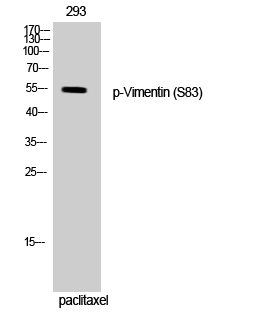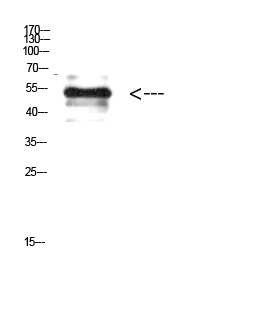Vimentin mouse mAb
- Catalog No.:YM1448
- Applications:WB;IF;IP
- Reactivity:Human
- Target:
- Vimentin
- Fields:
- >>Epstein-Barr virus infection;>>MicroRNAs in cancer
- Gene Name:
- vim
- Human Gene Id:
- 7431
- Human Swiss Prot No:
- P08670
- Mouse Swiss Prot No:
- P20152
- Immunogen:
- Purified recombinant human Vimentin protein fragments expressed in E.coli.
- Specificity:
- This antibody detects endogenous levels of Vimentin and does not cross-react with related proteins.
- Formulation:
- Liquid in PBS containing 50% glycerol, 0.5% BSA and 0.02% sodium azide.
- Source:
- Monoclonal, Mouse
- Dilution:
- wb dilution 1:1000 icc dilution 1:800. IF 1:50-200
- Purification:
- The antibody was affinity-purified from mouse ascites by affinity-chromatography using epitope-specific immunogen.
- Concentration:
- 1 mg/ml
- Storage Stability:
- -15°C to -25°C/1 year(Do not lower than -25°C)
- Other Name:
- CTRCT30;Epididymis luminal protein 113;FLJ36605;HEL113;OTTHUMP00000019224;VIM;VIME_HUMAN;Vimentin.
- Observed Band(KD):
- 57kD
- Background:
- This gene encodes a member of the intermediate filament family. Intermediate filamentents, along with microtubules and actin microfilaments, make up the cytoskeleton. The protein encoded by this gene is responsible for maintaining cell shape, integrity of the cytoplasm, and stabilizing cytoskeletal interactions. It is also involved in the immune response, and controls the transport of low-density lipoprotein (LDL)-derived cholesterol from a lysosome to the site of esterification. It functions as an organizer of a number of critical proteins involved in attachment, migration, and cell signaling. Mutations in this gene causes a dominant, pulverulent cataract.[provided by RefSeq, Jun 2009],
- Function:
- function:Vimentins are class-III intermediate filaments found in various non-epithelial cells, especially mesenchymal cells.,online information:Vimentin entry,PTM:One of the most prominent phosphoproteins in various cells of mesenchymal origin. Phosphorylation is enhanced during cell division, at which time vimentin filaments are significantly reorganized.,sequence caution:Intron retention.,similarity:Belongs to the intermediate filament family.,subunit:Homopolymer. Interacts with HCV core protein. Interacts with LGSN and SYNM.,tissue specificity:Highly expressed in fibroblasts, some expression in T- and B-lymphocytes, and little or no expression in Burkitt's lymphoma cell lines. Expressed in many hormone-independent mammary carcinoma cell lines.,
- Subcellular Location:
- Cytoplasm . Cytoplasm, cytoskeleton . Nucleus matrix . Cell membrane .
- Expression:
- Highly expressed in fibroblasts, some expression in T- and B-lymphocytes, and little or no expression in Burkitt's lymphoma cell lines. Expressed in many hormone-independent mammary carcinoma cell lines.
Transcription factor YY1 mediates epithelial–mesenchymal transition through the TGFβ signaling pathway in bladder cancer. MEDICAL ONCOLOGY Med Oncol. 2020 Oct;37(10):1-10 WB Human T24 bladder cancer cells
Upregulation of microRNA‑492 induced by epigenetic drug treatment inhibits the malignant phenotype of clear cell renal cell carcinoma in vitro. Molecular Medicine Reports Mol Med Rep. 2015 Jul;12(1):1413-1420 WB Human 1:500 786-O cell, ACHN cell
- June 19-2018
- WESTERN IMMUNOBLOTTING PROTOCOL
- June 19-2018
- IMMUNOHISTOCHEMISTRY-PARAFFIN PROTOCOL
- June 19-2018
- IMMUNOFLUORESCENCE PROTOCOL
- September 08-2020
- FLOW-CYTOMEYRT-PROTOCOL
- May 20-2022
- Cell-Based ELISA│解您多样本WB检测之困扰
- July 13-2018
- CELL-BASED-ELISA-PROTOCOL-FOR-ACETYL-PROTEIN
- July 13-2018
- CELL-BASED-ELISA-PROTOCOL-FOR-PHOSPHO-PROTEIN
- July 13-2018
- Antibody-FAQs
- Products Images
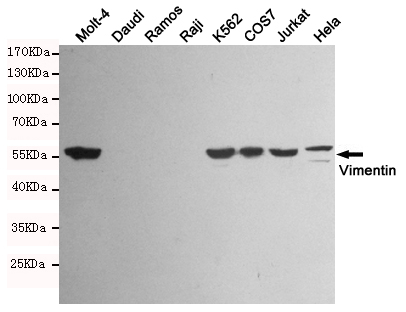
- Western blot detection of Vimentin in Molt-4,K562,COS7,Jurkat,Hela and Vimentin negative cell (Daudi,Ramos,Raji) lysates using Vimentin mouse mAb (1:1000 diluted).Predicted band size:57KDa.Observed band size:57KDa.
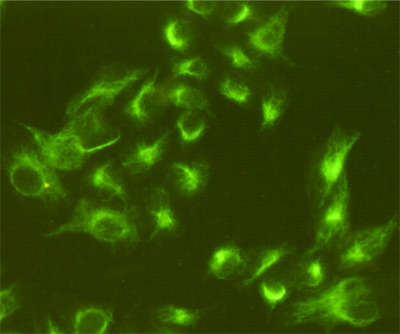
- Immunocytochemistry staining of Hela cells fixed with 4% Paraformaldehyde and using anti-Vimentin mouse mAb (dilution 1:800).
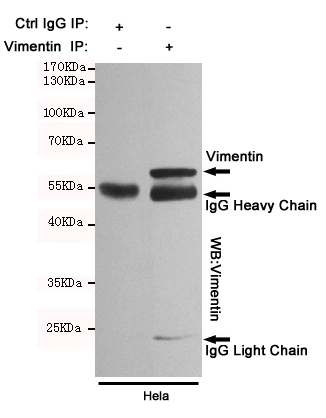
- Immunoprecipitation analysis of Hela cell lysates using Vimentin mouse mAb.
